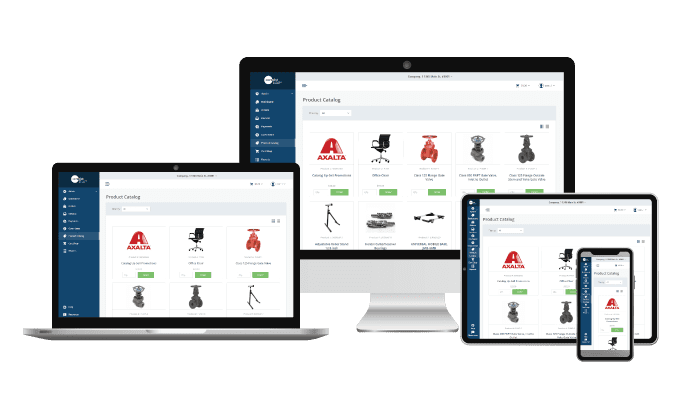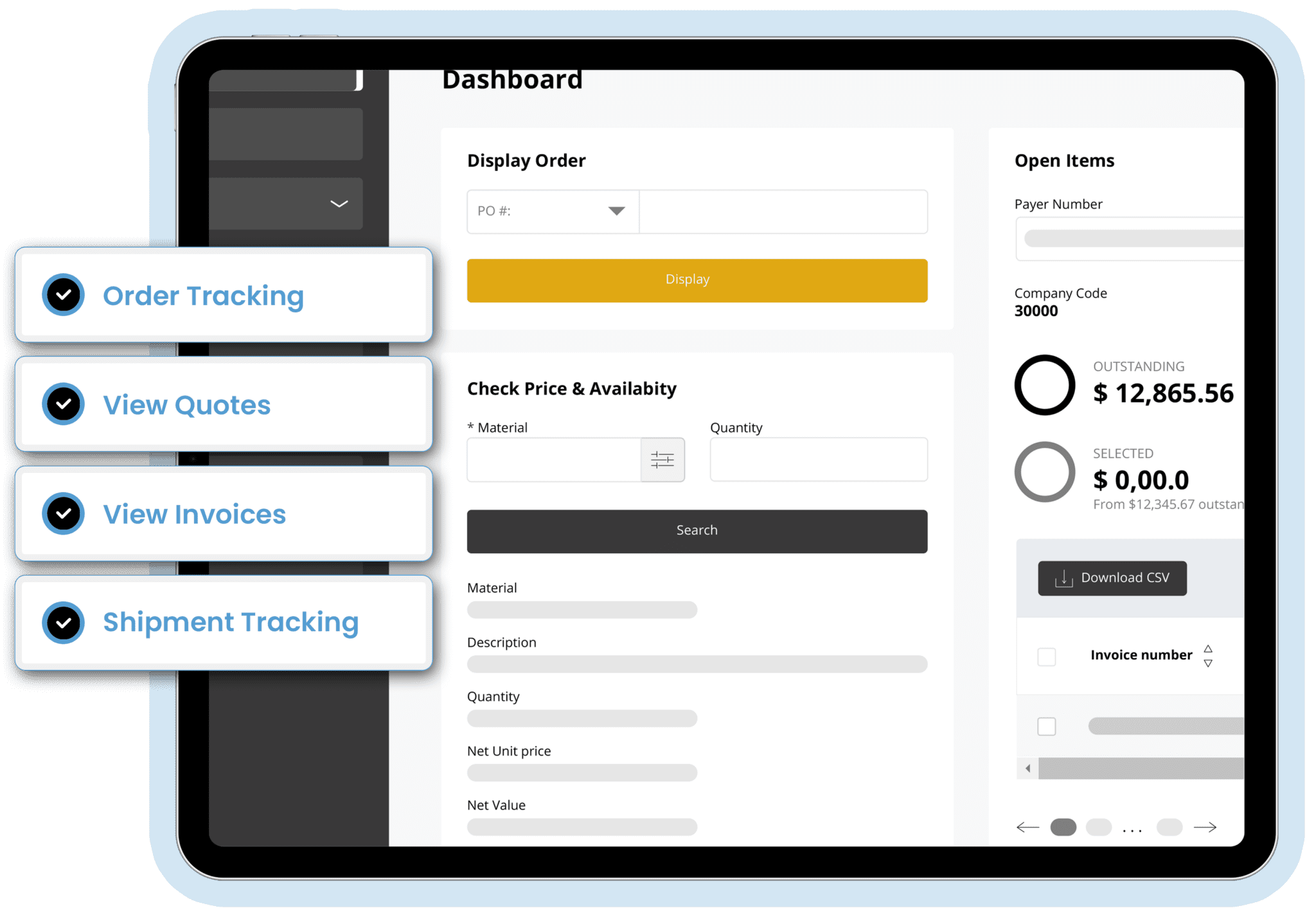EXCLUSIVE WHITEPAPER
7 Best Practices For B2B Customer Portals
What functionality should you tackle first?
And how do you handle ERP integration?
We’ll cover all that and more.

EXCLUSIVE WHITEPAPER
7 Best Practices For B2B Customer Portals
What functionality should you tackle first?
And how do you handle SAP ERP integration?
We’ll cover all that and more.

B2B customer portals have become a necessity in the digital age. But what goes into a good customer portal? What do your dealers and distributors need most—and what pitfalls should you watch out for?
While every organization will answer these questions differently, here are 7 high-level best practices. (Click to jump)
1. Put the voice of the customer first
2. Start with a goal to reduce phone, fax, & email inquiries
3. Give every customer the right data
4. Embrace “data discomfort”
5. Think B2C user experience
6. Don’t create more work for IT
7. Leverage economies of scale for SAP integration
1. Put the voice of the customer first

As you’re putting together your B2B portal project, you’ll encounter a lot of voices within the organization. Your head of customer service probably has a few ideas about the portal. Likewise, marketing and sales may have things they want to see (and a few they don’t want to see).
Once you bring in IT, you’ll get ideas on how the portal should (or shouldn’t) share data with other systems.
Every internal stakeholder has an important perspective. Trouble is, you can easily lose sight of the customer when you’re acting as a moderator between internal voices.
This is where some organizations get confused. The B2B customer portal is about the customer first. Internal concerns are important, but if there’s conflict, you have to weigh internal voices carefully against the needs of real customers.
So how do you find out what your dealers and distributors actually need?
It’s not enough to run a survey before you start the project. You need to involve dealers and distributors throughout the project itself, showing them live, working software. You need to ask them pointed questions like, “Why can’t we launch this B2B portal today? Why won’t it work for you?”
Their answers may surprise you—but they’re essential. The key is to follow a structure for iterative cycles of customer feedback and software configuration.
Hint: That’s what the Corevist project methodology is all about. It’s the key to launching a B2B portal that’s right for your customers.
2. Start with a goal to reduce phone, fax, & email inquiries
Where do you start as you transform customer experience?
This question will crush you if you’re not careful.
Indeed, massive transformation can be overwhelming. But the key is to limit the scope of your first project. Rather than fixing every broken window at once, you should start with low-hanging fruit. What can you solve in the next 30 days?
For many manufacturers, ending phone, fax, and email dependence is a great starting point. If your dealers and distributors are calling and emailing to get routine status checks for orders and invoices, why not launch a B2B customer portal that empowers them to self-serve?
If you choose a modular B2B portal solution (like the Corevist Platform), you can add product catalogs, online ordering, and digital payments when you’re ready.
In fact, many of our clients take this path. They start with order tracking and invoices in the portal. This functionality drives customer adoption because the value is so easy to realize. (No one wants to pick up the phone, right?) Once customers are using the portal for every routine inquiry, it’s easy for them to transition to online ordering when you add that functionality. It’s a smart, iterative path to improving your customer experience.
3. Give every customer the right data

A B2B portal isn’t much good if dealers and distributors won’t use it.
And they won’t use it if it doesn’t show their personalized data.
If you’re providing order and invoice tracking in the portal, then at the very least, every customer needs to see accurate historical data from SAP ERP. That means real-time status for every order, line item, shipment, invoice, and open accounting item. Your B2B customer portal will need to provide this information automatically without creating more work for IT (see #6 below).
If you add online ordering, it gets more complicated. How are you going to show the right contract pricing to each logged-in dealer? If each distributor has personalized inventory calculations (known as available to promise or ATP), how are you going to present that real-time data on the web?
Think about order errors, too—and the cost of manual callbacks. If your B2B portal accepts orders that SAP ERP will reject, how are you going to deal with that? Do you have the extra customer service staff to handle these issues?
These are all personalization problems, and they illustrate the incredible complexity of personalization in B2B. The requirements here cover every datapoint that your customer portal presents to the user.
You can solve all of these problems with the right SAP integration. But there’s an additional challenge here: Most IT teams can’t take on the burden of maintaining such a robust integration. (See #6 below.)
4. Embrace “data discomfort”
By now, you’re probably getting the picture. If that B2B portal is going to work for your customers, it’s going to need deep integration to SAP ERP.
And that integration might look a little scary.
We work with a lot of organizations who aren’t ready for customers to interact with SAP ERP through their B2B portal. In these cases, the company’s master data in SAP often needs a little cleanup. It wasn’t configured with customer interaction in mind, and after so many layers of configuration changes, it doesn’t even map to the company’s actual business processes.
While it’s challenging, a B2B portal project can force healthy change in this area. If the portal includes deep SAP integration (as the Corevist Platform does), it can act as a driver to simplify and streamline your internal processes. In particular, an integrated B2B portal will push you to be more customer-focused—both in your processes and your SAP configuration.
Ultimately, that’s a great exercise.
5. Think B2C user experience
Amazon has revolutionized the world—and with it, the expectations of B2B customers.
From online shopping, to banking, to ordering food, we all expect easy digital experiences now. Your customers are no different. They’ll bring those expectations to your B2B portal. You don’t want to create a user experience that’s difficult to understand or frustrating to use.
That’s why it’s best to choose a templatized solution. For example, the layout of the Corevst Platform is based on years’ worth of data analysis on the behavior of B2B users. Everything is arranged intuitively, putting key functionality right at the user’s fingertips.
6. Don’t create more work for IT
Clearly, you’ll need some degree of SAP integration for your B2B portal. But the more complex your business rules, the more complex your integration needs.
Do you have the IT resources to take on this new burden?
For many organizations, the answer is a hard “no.” The IT staff already has their hands full supporting existing systems. Between desktop support, internal systems, helping remote workers, and maintaining SAP ERP, the IT team just can’t take this on.
Here’s where a managed solution helps—but only if it includes SAP integration.
With a trusted partner owning the technology stack (including integration), you can focus on your core business. You don’t have to become a technology company or expand your IT department.
This is a big win if you’ve already invested in SAP ERP to define your business processes. In this scenario, a managed, integrated solution allows you to leverage all of that investment in your B2B customer portal. You don’t have to rebuild that value in the project phase, and you don’t have to keep it synced after GoLive.
7. Leverage economies of scale for SAP integration
 B2B customer portals are especially challenging for manufacturers with multiple brands or sales areas. If you need a deep SAP integration, how can you launch 5 or 10 or 25 portals efficiently—without rebuilding that integration?
B2B customer portals are especially challenging for manufacturers with multiple brands or sales areas. If you need a deep SAP integration, how can you launch 5 or 10 or 25 portals efficiently—without rebuilding that integration?
What about different user experiences for different brands? Or different languages for each country where you sell?
SAP integration architecture is the key here. You should look for a solution with a templatized integration—i.e. one that’s reusable for multiple portal experiences. This is especially helpful if you’re integrating all your portals back to the same SAP ERP system (or if you have multiple instances of SAP but they’re all configured the same).
When you find that reusability in a managed, integrated solution, you have a real win. You can stand up multiple portals around the globe (or for multiple brands) with minimal additional effort beyond the first rollout. This is the most efficient way to retire phone, fax, and email interaction at a global level.
Go deeper with supplemental content

Got questions?
We’ve got answers.
Ask a rep about our products, digital best practices, or whatever’s on your mind.


